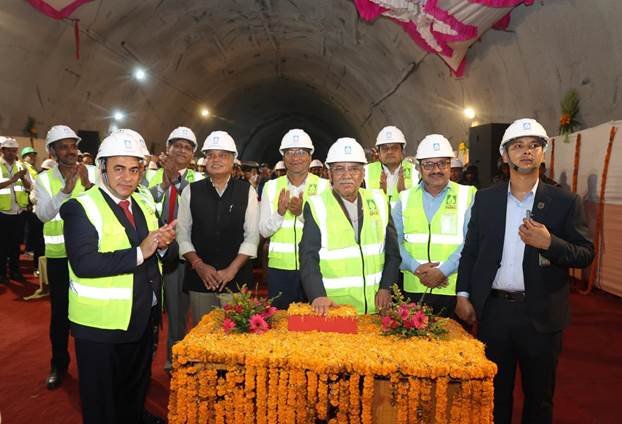Major Breakthrough in Nepal’s 900 MW Hydropower Project Constructed with Indian Assistance
Major Milestone for Nepal’s Energy Sector
Nepal’s energy sector has achieved a significant milestone with the major breakthrough in the 900 MW Arun-3 hydropower project. Constructed with substantial assistance from India, this project marks a pivotal development in Nepal’s renewable energy landscape. The hydropower plant is expected to contribute significantly to Nepal’s energy independence and economic growth, reinforcing the strong bilateral ties between Nepal and India.
India’s Role in Nepal’s Hydropower Development
The Arun-3 project exemplifies India’s commitment to assisting Nepal in its infrastructural development. India’s involvement includes financial aid, technical expertise, and logistical support, highlighting the robust cooperation between the two nations. This collaboration not only strengthens diplomatic relations but also sets a precedent for future projects in the region.
Economic and Environmental Benefits
The operationalization of the 900 MW hydropower project brings substantial economic and environmental benefits. It will provide a sustainable energy source, reducing Nepal’s reliance on imported fossil fuels and lowering greenhouse gas emissions. The project is expected to create numerous jobs, stimulate local economies, and contribute to the overall socio-economic development of the region.
Enhancing Regional Energy Security
This project is a cornerstone for enhancing regional energy security in South Asia. With its significant power generation capacity, the Arun-3 hydropower project will not only meet Nepal’s domestic energy needs but also has the potential to export surplus power to neighboring countries, thereby fostering regional energy cooperation and stability.
Technical Specifications and Project Details
The Arun-3 hydropower project, located in the Sankhuwasabha District of eastern Nepal, harnesses the power of the Arun River. It includes a 70-meter high dam, a 3.5-kilometer headrace tunnel, and four generating units. The project’s construction involved cutting-edge technology and adherence to international environmental and safety standards, ensuring its sustainability and reliability.

Why This News is Important
Strengthening Bilateral Relations
This breakthrough in the Arun-3 hydropower project significantly strengthens the bilateral relations between Nepal and India. It underscores the importance of collaborative efforts in infrastructural development, which can serve as a model for future projects.
Boosting Nepal’s Economy
The project is poised to boost Nepal’s economy by providing a reliable and sustainable energy source. This will attract more investments, promote industrial growth, and create job opportunities, contributing to the nation’s economic stability and growth.
Advancing Renewable Energy Goals
In the context of global climate change, the Arun-3 hydropower project represents a substantial step forward in advancing renewable energy goals. It demonstrates Nepal’s commitment to sustainable development and reducing carbon emissions, aligning with global environmental objectives.
Regional Energy Cooperation
The project’s potential to export surplus energy enhances regional energy cooperation. It highlights the benefits of regional collaboration in achieving energy security and stability, which is crucial for the overall development of South Asia.
Innovation in Infrastructure Development
The successful implementation of this project showcases innovative approaches in infrastructure development. It sets a benchmark for future hydropower projects, emphasizing the importance of technological advancements and adherence to international standards.
Historical Context: Nepal’s Hydropower Development
Early Developments in Hydropower
Nepal has long been recognized for its vast hydropower potential, owing to its numerous rivers and steep topography. The history of hydropower development in Nepal dates back to the early 20th century, with small-scale projects that laid the foundation for larger initiatives.
India-Nepal Cooperation
The cooperative efforts between India and Nepal in the energy sector have a rich history. The two countries have engaged in several joint projects aimed at harnessing Nepal’s hydropower potential, with the Arun-3 project being one of the most significant undertakings in recent times.
Environmental and Economic Shifts
Over the decades, shifts in environmental policies and economic strategies have shaped Nepal’s approach to hydropower development. The increasing emphasis on renewable energy and sustainable development has driven investments in large-scale projects like Arun-3, reflecting a broader commitment to addressing climate change and economic growth.
Key Takeaways from the Major Breakthrough in Nepal’s 900 MW Hydropower Project
| Serial Number | Key Takeaway |
|---|---|
| 1 | The 900 MW Arun-3 hydropower project marks a significant milestone in Nepal’s renewable energy sector. |
| 2 | The project is a result of robust cooperation between India and Nepal, showcasing strong bilateral relations. |
| 3 | It brings substantial economic benefits, including job creation and industrial growth, boosting Nepal’s economy. |
| 4 | The hydropower project advances Nepal’s renewable energy goals and contributes to regional energy security. |
| 5 | The successful implementation highlights innovative infrastructure development and adherence to international standards. |
Important FAQs for Students from this News
Q1: What is the capacity of the Arun-3 hydropower project?
A1: The Arun-3 hydropower project has a capacity of 900 MW.
Q2: Where is the Arun-3 hydropower project located?
A2: The Arun-3 hydropower project is located in the Sankhuwasabha District of eastern Nepal.
Q3: What role did India play in the Arun-3 project?
A3: India provided financial aid, technical expertise, and logistical support for the Arun-3 project, highlighting strong bilateral cooperation between India and Nepal.
Q4: How does the Arun-3 project benefit Nepal economically?
A4: The project benefits Nepal economically by providing a sustainable energy source, creating jobs, stimulating local economies, and attracting investments.
Q5: What are the environmental benefits of the Arun-3 hydropower project?
A5: The environmental benefits include reducing Nepal’s reliance on imported fossil fuels and lowering greenhouse gas emissions, contributing to sustainable development.
Some Important Current Affairs Links

















